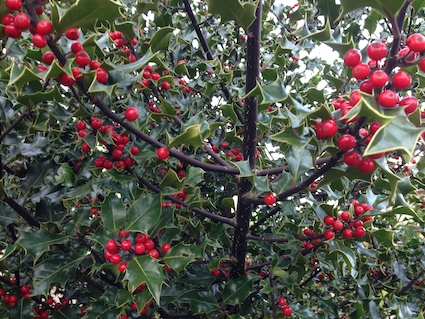
In 2005 I planted a holly tree in front of my house. It has grown slowly but steadily and since 2014 has consistently produced berries being a female tree. This does surprise me because there are no holly trees that I can see nearby. My understanding is that the flowers need to be fertilised from a nearby male tree. So I thank the insects who did the pollination! Every year I’m aware just how pretty the berries are. I am secretly delighted that the local thrush population don’t strip the the tree bare of berries in the Autumn.
With Christmas fast approaching.I always like to remind myself about holly and its stories.
Holly (Ilex aquifolium) can be found all over the UK as it is a hardy tree which thrives in all but wet soil. Some people believe it is unlucky to cut down a holly tree and so isolated trees can be found as well as those growing in hedgerows. The most informative book I have has to be A Tree in Your Pocket by Jacqueline Memory Paterson. It details all the folklore, uses, customs and other information about holly and other British native trees.
I did want to find out how holly became associated with Christmas. According to Roger Phillip, in his book Herbs, “The tradition of using holly to decorate churches and houses at Christmas dates back to the Roman custom of sending gifts decorated with holly boughs to friends at the Festival of Saturnalia, and this custom was adopted by Christians for their Christmas celebrations which occur only a week after Saturnalia. The Druids also decorated their huts with evergreens as an abode for sylvan spirits (e.g. faeries and elves) during winter. Holly is considered a plant of good omen because its bright green leaves and berries symbolise life in the midst of winter. Another legend states that holly first sprang under Christ’s footsteps and the thorny leaves and red berries symbolise his suffering and wounds, hence the tree’s other common names: Christ’s Thorn and Holy Tree.“
Scottish Forestry have produced a useful resource – Tree Stories written by storyteller Claire Hewitt. It comprises of a tree story for each month of the year, background facts on each tree and its folklore, as wells as an introduction to storytelling. It is a useful download. The story of holly and pine is a sweet one and well worth learning and telling to your own class or group of children should you discover a nearby tree. Here is my retelling summary:
It all begins with a little robin who has broken his wing, in the middle of a cold, snowy winter and realises that he needs to find some food and shelter where he can stay for a while until his wing gets better. He hops over to the nearest tree, a slender silver birch and asks her for protection. The birch tree gazes sadly at the robin and explains she has no food and her leaves are too fine. She sends him over to the big oak tree. The big oak tree is slumbering deeply. He doesn’t hear the robin and his request for shelter and food and just keeps on sleeping. So poor robin hops on and asks another tree. None of them will help. Eventually he ends up at a stand of ancient Scot’s Pine trees. The pine trees offer to protect the robin but worry that their needles are too fine and that they don’t have food. So they suggest trying holly – a solitary tree in their midst. To attract holly’s attention, the pine trees advise robin to sing a song. Robin sings so beautifully that holly wakes up and shakes herself. Several bright berries fall to the ground at the robin’s feet, twinkling red against the white snow. Holly is so pleased to hear robin’s song that she invites him to stay within her branches until he gets better and where he has lots of berries to eat. When the Creator saw and heard what had happened, he decided to give Scot’s Pine and Holly the gift of being green all year round as a reminder to others of their generosity. It is also why robin can still be found singing his song in winter to this very day.
When telling a story like this, it can be helpful to have photos of the trees mentioned and the robin. If possible have samples of their leaves and other material for the children to feel and examine. This makes the experience more real. Have a look in your local area and see if any of the trees are nearby. Go and visit so that children learn about these trees. It’s even better if the story can by retold beside them.
Regardless, enjoy the abundance of berries to be seen at this time of year and cherish the traditions and stories that come with the plants that bear them.
This blog post was originally published in November 2014.




















Trackbacks/Pingbacks